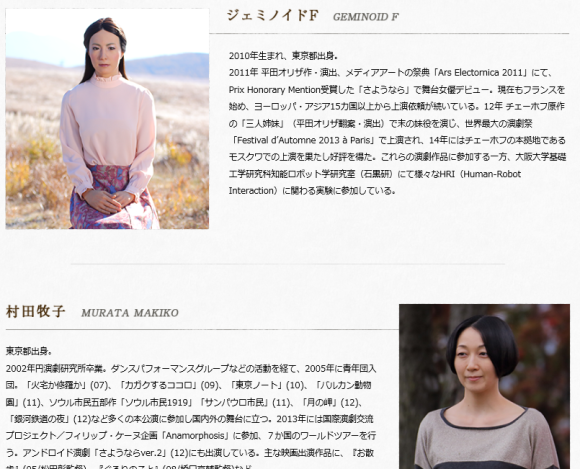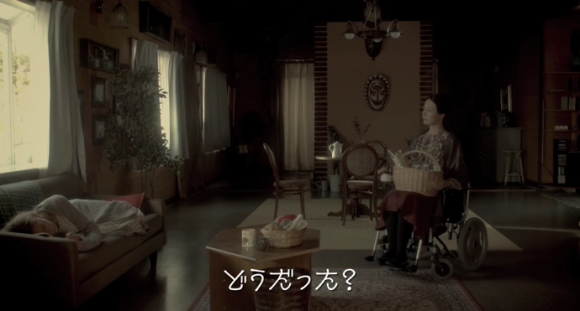
A delegation of anime huggy pillows appeared on the red carpet at the recent Tokyo International Film Festival, but they weren’t the only non-human stars whose work was featured at the event. Also screening was Sayonara, a new film written and directed by Koji Fukuda. The fact that one of the Japanese-produced movie’s two female leads is a foreigner would be notable enough on its own, but what really makes Sayonara unique is that her costar is an android.
Sayonara features American actress Bryerly Long as Tania, a woman living in the Japanese countryside. In a story choice that’s clearly meant to be evocative of the real-life Fukushima nuclear incident of 2010, the Japan depicted in Sayonara has become severely contaminated with radiation, and residents of the country are being evacuated to other nations.
But, due to the scale of the undertaking, not everyone can leave Japan at once. Evacuees are assigned a priority number, and Anna’s is especially low, meaning that she stays behind as the surrounding area becomes progressively deserted. She’s not totally alone, though, because with her is Leona, the helper android who’s been by Tania’s side since she was a sickly child.
Leona isn’t a heavily made-up actress, though. Nor is she a digital effect adding in post-production. The role is played by an actual robot, created by researcher Hiroshi Ishiguro. Ishiguro is best known for his Geminoid HI-2, an android which he modeled after himself, right down to its initials. Appearing in Sayonara is an even more lifelike machine, the Geminoid F, presumably standing for “Female.”
But despite her inorganic status, Sayonara treats its android actress with all the deference of a regular cast member, so much so that we’re not sure if we should use “the” before Geminoid F.
▼ Geminoid F’s cast listing on the movie’s official website, which includes the information “Born 2010 in Tokyo”
But while Geminoid F, which is remotely operated, can speak and alter its expression, it can’t walk. The film’s producers get around this by making Leona a robot with a damaged knee and siting her in a wheelchair.
A lack of mobility isn’t the only limitation Leona has, though. As a robot, she can’t understand the concept of death, but that’s the very issue that Tania, sick with radiation poisoning, is dealing with. As a matter of fact, the entire film seems wrapped in a slowly but irreversibly advancing sense of finality, with streams of evacuees marching past fields of withering vegetation in the pale light of the late afternoon.
With advanced humanoid robots, there’s always the danger of repulsing the audience with an appearance that falls within the unnerving uncanny valley. As shown in the trailer, though, Geminoid F appears to have avoided this pitfall, with the overall effect far less creepy than that of many other androids. And in one particularly powerful shot of the two leads, it almost seems like Tania has become the robot and Leona the human, as the afflicted woman’s face becomes a mask of panic-hardened fear, while her helper machine adopts a serene, understanding countenance.
Struggling to grasp what it means to be alive, and for life to end, Anna can be heard in the preview offering her half-formed conceptualization. “When night falls, we look at the stars. During the day, we talk to many different people. And then, I think, we find what we love most. Once we find it, we treasure it, and live until we die.”
Sayonara opens at theaters in Japan on November 21. A listing of theaters screening the film can be found here.
Related: Sayonara official website
Source: The Telegraph
Top image: YouTube/PHANTOM FILM
Insert images: YouTube/PHANTOM FILM, Sayonara official website







 Japan’s giant robot proliferation continues as filming starts on live-action Patlabor movie
Japan’s giant robot proliferation continues as filming starts on live-action Patlabor movie Japan’s new life-size Gundam is complete and standing proud in Yokohama!【Photos/Video】
Japan’s new life-size Gundam is complete and standing proud in Yokohama!【Photos/Video】 Behind-the-scenes video shows the CG process used to create Japan’s new Godzilla 【Video】
Behind-the-scenes video shows the CG process used to create Japan’s new Godzilla 【Video】 Japan’s hyper-realistic CG schoolgirl moves for the first time in new video【Video】
Japan’s hyper-realistic CG schoolgirl moves for the first time in new video【Video】 Japan’s Godzilla movie looks darker than ever in director Hideaki Anno’s new trailer【Video】
Japan’s Godzilla movie looks darker than ever in director Hideaki Anno’s new trailer【Video】 We revisited Sweets Paradise after a decade to see if Japan’s dessert buffet still delivers
We revisited Sweets Paradise after a decade to see if Japan’s dessert buffet still delivers Starbucks Japan ready to get Year of the Horse started with adorable drinkware and plushies【Pics】
Starbucks Japan ready to get Year of the Horse started with adorable drinkware and plushies【Pics】 Hayao Miyazaki says Happy New Year to Studio Ghibli fans with new art for Year of the Horse
Hayao Miyazaki says Happy New Year to Studio Ghibli fans with new art for Year of the Horse Survey finds more than 70 percent of Japanese children have an online friend
Survey finds more than 70 percent of Japanese children have an online friend Randy’s Donuts opens first-ever branch in Japan, brings L.A.’s donuts to Tokyo【Photos】
Randy’s Donuts opens first-ever branch in Japan, brings L.A.’s donuts to Tokyo【Photos】 Super long ebi fry proves Japanese portion sizes aren’t always small
Super long ebi fry proves Japanese portion sizes aren’t always small Biryani Restaurant in the Middle of Tokyo Offers a Delightful Taste of Spice with Your Rice, Open One Day a Week
Biryani Restaurant in the Middle of Tokyo Offers a Delightful Taste of Spice with Your Rice, Open One Day a Week Is the all-you-can-eat KFC buffet in Tokyo really as good as they say it is?
Is the all-you-can-eat KFC buffet in Tokyo really as good as they say it is? Typhoon destroys real Ghost of Tsushima island shrine torii gate, crowdfunding campaign launched
Typhoon destroys real Ghost of Tsushima island shrine torii gate, crowdfunding campaign launched Harajuku’s new permanent Tamagotchi shop is filled with cuteness and a surprising lack of poop
Harajuku’s new permanent Tamagotchi shop is filled with cuteness and a surprising lack of poop 7-Eleven Japan’s ramen-cooking robot whipped us up a bowl of noodles【Taste test】
7-Eleven Japan’s ramen-cooking robot whipped us up a bowl of noodles【Taste test】 Cyberpunk anime meets traditional culture in Ghost in the Shell gold leaf Japanese changing screens
Cyberpunk anime meets traditional culture in Ghost in the Shell gold leaf Japanese changing screens 7 great places to see Mt. Fuji from without having to climb it
7 great places to see Mt. Fuji from without having to climb it Hello Kitty Choco Egg figures are an adorable trip through three periods of Japanese pop culture【Pics】
Hello Kitty Choco Egg figures are an adorable trip through three periods of Japanese pop culture【Pics】 Japan’s otoshidama tradition of giving kids money at New Year’s gets a social welfare upgrade
Japan’s otoshidama tradition of giving kids money at New Year’s gets a social welfare upgrade We found possibly the quietest Japanese-style hotel in Tokyo’s bustling Shinjuku district
We found possibly the quietest Japanese-style hotel in Tokyo’s bustling Shinjuku district Lacquerware supplier to emperor of Japan and Pokémon team up for new tableware
Lacquerware supplier to emperor of Japan and Pokémon team up for new tableware Sumo Sanrio! Hello Kitty and pals team up with Japan Sumo Association for new merch【Pics】
Sumo Sanrio! Hello Kitty and pals team up with Japan Sumo Association for new merch【Pics】 Can a dirty butthole make you filthy rich in Japan? We’re starting a New Year’s lottery experiment
Can a dirty butthole make you filthy rich in Japan? We’re starting a New Year’s lottery experiment 7-Eleven Japan starts new temporary luggage storage service in over 300 branches
7-Eleven Japan starts new temporary luggage storage service in over 300 branches Disillusionment at Tsukiji’s tourist-target prices led us to a great ramen restaurant in Tokyo
Disillusionment at Tsukiji’s tourist-target prices led us to a great ramen restaurant in Tokyo Starbucks teams up with 166-year-old Kyoto doll maker for Year of the Horse decorations【Photos】
Starbucks teams up with 166-year-old Kyoto doll maker for Year of the Horse decorations【Photos】 Tokyo considering law requiring more trash cans following litter increase in heavily touristed area
Tokyo considering law requiring more trash cans following litter increase in heavily touristed area Tokyo’s Tsukiji sushi neighborhood asks tour groups to stay away for the rest of the month
Tokyo’s Tsukiji sushi neighborhood asks tour groups to stay away for the rest of the month Nintendo’s Kirby now delivering orders at Kura Sushi restaurants, but not in Japan
Nintendo’s Kirby now delivering orders at Kura Sushi restaurants, but not in Japan Tokyo event lets you travel back in time, for free, to celebrate 100 years since Showa era start
Tokyo event lets you travel back in time, for free, to celebrate 100 years since Showa era start Sanrio theme park in Japan announces plans to expand into a Sanrio resort
Sanrio theme park in Japan announces plans to expand into a Sanrio resort Japan may add Japanese language proficiency, lifestyle classes to permanent foreign resident requirements
Japan may add Japanese language proficiency, lifestyle classes to permanent foreign resident requirements Survey asks foreign tourists what bothered them in Japan, more than half gave same answer
Survey asks foreign tourists what bothered them in Japan, more than half gave same answer Japan’s human washing machines will go on sale to general public, demos to be held in Tokyo
Japan’s human washing machines will go on sale to general public, demos to be held in Tokyo Japan’s deadliest food claims more victims, but why do people keep eating it for New Year’s?
Japan’s deadliest food claims more victims, but why do people keep eating it for New Year’s? We deeply regret going into this tunnel on our walk in the mountains of Japan
We deeply regret going into this tunnel on our walk in the mountains of Japan Studio Ghibli releases Kodama forest spirits from Princess Mononoke to light up your home
Studio Ghibli releases Kodama forest spirits from Princess Mononoke to light up your home Major Japanese hotel chain says reservations via overseas booking sites may not be valid
Major Japanese hotel chain says reservations via overseas booking sites may not be valid Put sesame oil in your coffee? Japanese maker says it’s the best way to start your day【Taste test】
Put sesame oil in your coffee? Japanese maker says it’s the best way to start your day【Taste test】 No more using real katana for tourism activities, Japan’s National Police Agency says
No more using real katana for tourism activities, Japan’s National Police Agency says Starbucks Japan reveals new sakura drinkware collection, inspired by evening cherry blossoms
Starbucks Japan reveals new sakura drinkware collection, inspired by evening cherry blossoms Updated cherry blossom forecast shows extra-long sakura season for Japan this year
Updated cherry blossom forecast shows extra-long sakura season for Japan this year Stars of Japan’s longest-running anime get gorgeous modern makeover in new video【Video】
Stars of Japan’s longest-running anime get gorgeous modern makeover in new video【Video】 Japan’s nine-year-old karate champion returns—in Australian singer Sia’s new music video【Video】
Japan’s nine-year-old karate champion returns—in Australian singer Sia’s new music video【Video】
Leave a Reply